Chrissy and I were invited by Travis Paris, Geologist and President of the Knoxville Gem & Mineral Society (KGMS), to join him at a couple rockhounding locations in Union County, East Tennessee.
We met Travis and KGMS Secretary, Janice Erickson, at a pre-arranged location. Our first of two stops that day was a kimberlite outcrop on the shoreline of Norris Lake. We followed them on winding country roads into a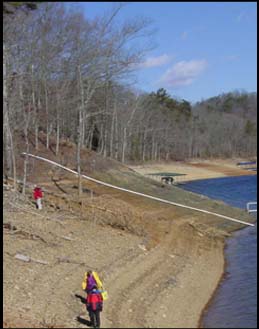 housing development that consisted mostly of high-dollar summer cottages on and near the lake. Although it had been some time since Travis had last visited the kimberlite and the roads were like a maze, he managed to find the spot where he and others had always parked on previous trips. We hiked down to the shoreline and a couple hundred yards to the kimberlite outcrop.
housing development that consisted mostly of high-dollar summer cottages on and near the lake. Although it had been some time since Travis had last visited the kimberlite and the roads were like a maze, he managed to find the spot where he and others had always parked on previous trips. We hiked down to the shoreline and a couple hundred yards to the kimberlite outcrop.
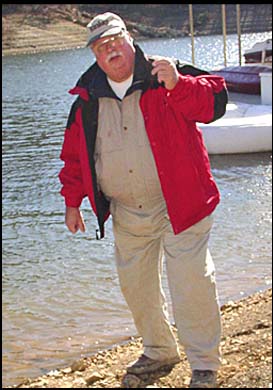 Travis told us what he knew about the Kimberlite. Kimberlite pipes are the result of explosive diatreme volcanism from very deep mantle derived sources. These volcanic explosions produce vertical columns of rock that rise from deep magma reservoirs. Kimberlites will often contain diamonds. The deposits at Kimberley, South Africa were the first recognized and the source of the name. This particular micaceous kimberlite had intruded limestones and sandstones. The rock was made up of a complex assemblage of minerals, but was perhaps best known by rockhounds to contain small euhedral magnetite crystals. So, it didn't take long before all eyes and some bodies were on the ground.
Travis told us what he knew about the Kimberlite. Kimberlite pipes are the result of explosive diatreme volcanism from very deep mantle derived sources. These volcanic explosions produce vertical columns of rock that rise from deep magma reservoirs. Kimberlites will often contain diamonds. The deposits at Kimberley, South Africa were the first recognized and the source of the name. This particular micaceous kimberlite had intruded limestones and sandstones. The rock was made up of a complex assemblage of minerals, but was perhaps best known by rockhounds to contain small euhedral magnetite crystals. So, it didn't take long before all eyes and some bodies were on the ground.
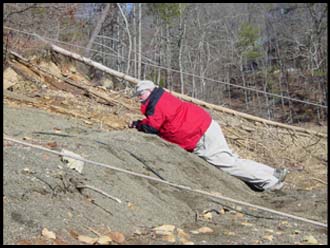
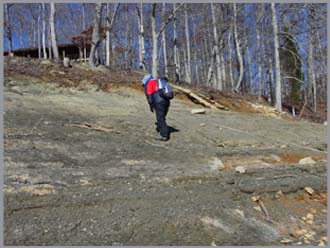
As a micromineral enthusiast, Janice was particularly in her element.

Chrissy was all smiles after finding what Travis said was one the biggest and finest magnetite crystals from that location that he had ever seen.
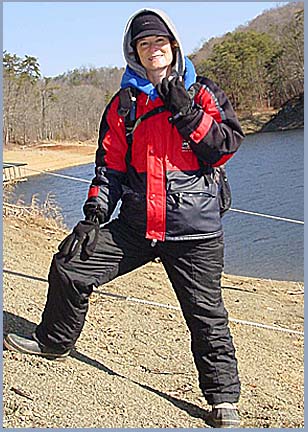
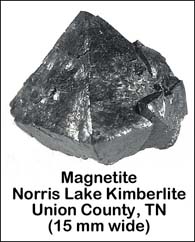
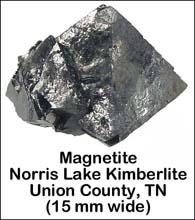
Click on specimen pictures to enlarge
We all managed to find a bunch of decent magnetite specimens and some unusual green colored sandstone before the wind chill factor drove us away from the frigid lake and toward our next destination.
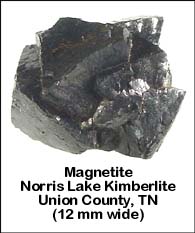
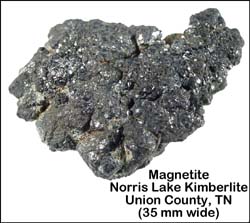
Click on specimen pictures to enlarge
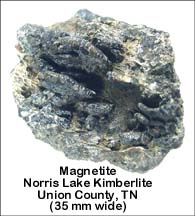
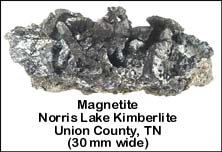
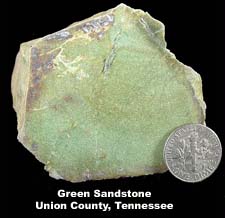
The Powell River area in northeastern Union County and adjoining western Claiborne County is one of the most pervasively mineralized areas in East Tennessee. A northwest-treading belt of zinc and lead mines and prospects extend along the Powell River for fifteen miles. Within this belt more zinc and lead occurrences are known than in any other area of comparable size in East Tennessee. Travis took us to an abandoned lead-zinc mine that had been worked sporadically from the late 1800s to the mid 1940's.
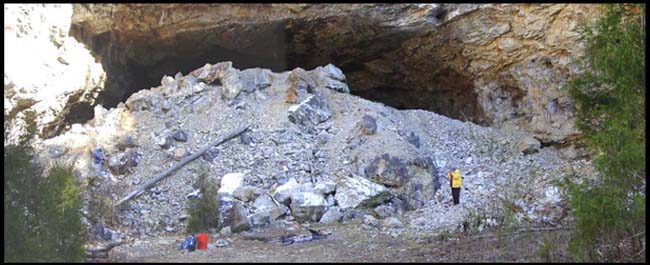
According to Travis, the mine that we visited was not known
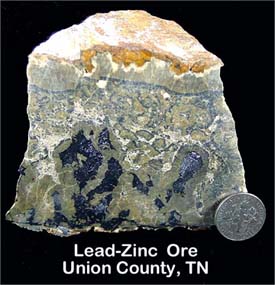
for its crystallized mineral specimens. However, he pointed out several large boulders that contained layers of lead zinc ore with massive sphalerite, galena, limonite and cerussite. I reduced the boulders to manageable sizes for transport. I later slabbed and polished the rock and its brecciated nature became more obvious. The shiny silver galena is especially striking on the polished surface (looks black in the picture to the right).
The mine looked relatively safe, so I couldn't resist venturing inside. I discovered that the mine extended back into the hillside approximately 150
yards.
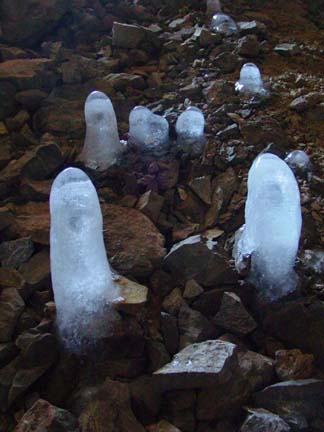 A shaft had been extended from the surface to near the far end of the
underground workings. Light filtering down from the shaft and entering from the main opening prevented any part of the mine from being completely dark, although a good flashlight was certainly necessary to navigate an uneven boulder-strewn floor. Water dripping down from above combined with many nights of sub-freezing temperatures to form rounded ice stalagmites. Although interesting from a geologic standpoint, the inside of the mine did not appear to offer anything in the way of collectible mineral specimens so I made my way back out into the light.
A shaft had been extended from the surface to near the far end of the
underground workings. Light filtering down from the shaft and entering from the main opening prevented any part of the mine from being completely dark, although a good flashlight was certainly necessary to navigate an uneven boulder-strewn floor. Water dripping down from above combined with many nights of sub-freezing temperatures to form rounded ice stalagmites. Although interesting from a geologic standpoint, the inside of the mine did not appear to offer anything in the way of collectible mineral specimens so I made my way back out into the light.
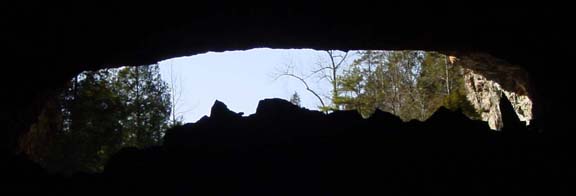
Once outside, I started sniffing around the big pile of rocks in front of the mine entrance. Although Travis hadn't seen or heard any crystals other than a few micros being found at the mine, I figured that it couldn't hurt to look around and maybe bust a few rocks anyway. Maybe something that nobody had found before was hiding inside one of those big boulders . . .
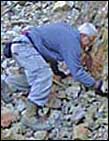 While I was scampering around outside during the late afternoon, a very slight indentation beneath a limestone outcrop at the base of the rock pile beckoned me with a very soft voice. Upon noticing it, I wondered if some other rockhound had been scratching in this spot and, if so, why? Within about 15 minutes, I discovered what appeared to be a layer of very rich galena ore surrounded by rust colored gossan. Gossan is intensely oxidized, weathered or
decomposed rock, usually the upper and exposed part of an ore deposit or mineral vein. It wasn't exactly crystals, but from what I could see, the layer was almost all galena and at least worthy of extracting a few representative chunks. But, getting to the metallic layer was easier said than done and it
took me about half an hour of heavy duty banging to extract a decent size
While I was scampering around outside during the late afternoon, a very slight indentation beneath a limestone outcrop at the base of the rock pile beckoned me with a very soft voice. Upon noticing it, I wondered if some other rockhound had been scratching in this spot and, if so, why? Within about 15 minutes, I discovered what appeared to be a layer of very rich galena ore surrounded by rust colored gossan. Gossan is intensely oxidized, weathered or
decomposed rock, usually the upper and exposed part of an ore deposit or mineral vein. It wasn't exactly crystals, but from what I could see, the layer was almost all galena and at least worthy of extracting a few representative chunks. But, getting to the metallic layer was easier said than done and it
took me about half an hour of heavy duty banging to extract a decent size
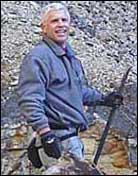 piece. Upon the rock's retrieval, I noticed that the top had metallic protrusions sticking up through a layer of beige, rust and tan colored crud. Had I found crystals after all?
piece. Upon the rock's retrieval, I noticed that the top had metallic protrusions sticking up through a layer of beige, rust and tan colored crud. Had I found crystals after all?
To make a long story short, I had somehow managed to discover a rich layer of galena that had, perhaps, partially formed in open spaces and rock voids to form oddly shaped stalagmites, stalagmites and other forms. The beige encrusting material is very finely crystalline cerussite, a product of oxidation of the galena. Scattered on much of oxidized surfaces, are tiny crystals of sparkling white cerussite up to 2mm in length on limonite. Coolio!!!
The following pictures show some of the specimens that I recovered.
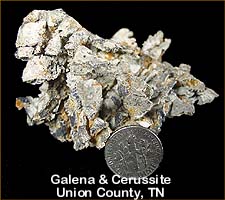
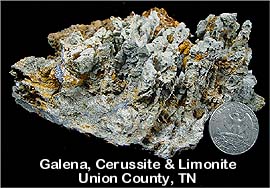
Click on specimen pictures to enlarge
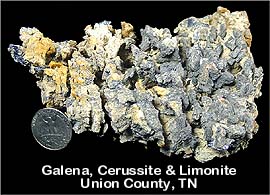
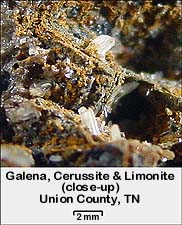
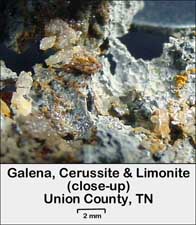
Since I didn't discover the galena layer until late afternoon, it was pretty darned cold and everyone besides me was freezing their hinnies off watching me dig, I decided to stop and maybe come back another day to see what else that limestone outcrop was hiding.
Many thanks to Travis for showing us a couple of his East Tennessee spots and to Janice for being a most enthusiastic rockhounding companion.